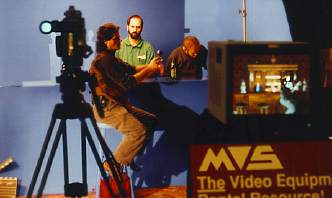
Welcome to the world of Blue Screen / Green Screen compositing! Once the exclusive domain of Hollywood special effects artists, blue screen compositing expanded to include video and computer imaging. There are many mysteries to the succesful execution of a blue screen composite and considerable confusion as to what a blue screen composite is.
What is Blue Screen Imaging?
Creating a blue screen composite image starts by photographing a subject in front of an evenly lit, bright, pure blue (or green) background. The compositing process, whether photo-chemical or digital, replaces all the blue in the picture with another image, known as the background plate.
Blue screen composites can be made optically for still photos or movies, with dedicated real time hardware for live video, and digitally using software to composite still and motion images. Until the the 1990s most blue screen compositing for films was done optically, and all television composites were done using analog real time hardware.
In addition to blue, other colors can be used. While green has become the most common; sometimes red has been used for special purposes.
Another term for Blue Screen is Chroma-Key. Chroma-Key is a television process only. A more sophisticated television process is Ultimatte; also the name of the company that manufactures Ultimatte equipment. Ultimatte has been the ultimate in video compositing for 20 years. With an Ultimatte unit it is possible to create composites that include smoke, transparent objects, different shades of blue, and shadows. Ultimatte now makes software that works with other programs to create digital mattes, either as a standalone program, or as a filter for programs such as Photoshop and After Effects from Adobe.
How does Chroma Key work?
The Chroma Key process is based on the luminance key. In a luminance key, everything in the image over (or under) a set brightness level is "keyed" out and replaced by either another image, or a color from a color generator. (Think of a keyhole or a cookie-cutter.) For example, a title card with white on black titles is prepared and placed in front of a camera. The camera signal is fed into the keyer's foreground input. The background video is fed into the keyer. The level control knob on the keyer is adjusted to cause all the black on the title card to be replaced by the background video. The white letters now appear over the background image.
Luminance keying works great with titles, but not so great for making live action composites. When we want to key people over a background image, problems arise because people and their clothing have a wide range of luminance tones. Hair, shoes and shadow areas may be very dark, while eyes, skin highlights and shirt collars can approach 100% white. Those areas might key through along with the backdrop.
Chroma Key creates keys on just one color channel. Broadcast and high end consumer cameras
cameras use three independent sensors, one for each primary color-- Red, Green and
Blue. Many cameras can output these RGB signals separately from the composite
video signal. So the original chroma key was probably created by feeding the
blue channel of a camera into a luminance keyer. This works, sort of, but soon manufacturers
created dedicated chromakeyers that could accept all 3 colors, plus the background
composite signal, and the foreground composite signal. This made it possible
to select any color for the key and fine tune the selection of the color tint, chroma level and luminance level.
As keyers became more sophisticated, with finer control
of the transition between background and foreground, the effect became less
obvious and jarring. Today's high-end keyers can make a soft key that is essentially undetectable. Some of the best modern Special Effects Generator Switchers from Grass Valley Group, Sony, and others can create composites rivaling the performance of a dedicated Ultimatte unit. (Though they are not as good at removing blue spill, working through water or fabric, etc.)
Why Blue? Can't other colors be used?
Red, green and blue channels have all been used, but blue
has been favored for several reasons. Blue is the complementary color to flesh
tone--since the most common color in most scenes is flesh tone, the opposite
color is the logical choice to avoid conflicts. Historically, cameras and
film have been most sensitive to blue light, although this is less true today.
Green has its own advantages, beyond the obvious one of
greater flexibility in matting with blue foreground objects. Green paint
has greater reflectance than blue paint, which can make matting easier. Also,
video cameras are usually most sensitive in the green channel, and often have
the least noise in that channel. A disadvantage is that green
spill is almost always objectionable and obvious even in small amounts, while
blue can sometimes slip by unnoticed.
Sometimes (usually) the background color reflects onto
the foreground talent creating a slight blue tinge around the edges. This
is known as blue spill. It doesn't look nearly as bad as green spill, which
one would get from green.
Traditionally, a single camera was used as the Chroma Key camera. This creates a problem on three camera sets; the other cameras can see the blue screen. The screen must be integrated into the set design, and it is easier to design around a bright sky blue than an intense green or red. However, modern Special Effects Generators (Usually just called "Switchers" in the US, more accurately called "Vision Mixers" in the UK and elsewhere) can accommodate multiple camera sources, whether as RGB analog, or SDI video, inputs.
